 | Canadian Pacific Odds and Ends - Part 8 Articles |
Canadian Pacific Railway Celebrates its Diamond Jubilee - Montreal Gazette 1941. The "Last Call" page has appeared weekly on OKthePK's web site over the past couple of years. Each week a different article told the story about various railway items of interest. While some of the articles were saved they were no longer available online. Several of those about the Canadian Pacific Railway have been compiled here on this page. There is insufficient room to display more than a few articles per page. As a result, "Canadian Pacific Odds and Ends - Part 8", continues this month with more possible parts to follow as time progresses. Every month they will be archived to the CPR Set-off Siding web site for future online retrieval. Look under the articles section on the CPR Set-off Siding web site to find these archived pages. 
Canadian Pacific Railway Celebrates its Diamond Jubilee 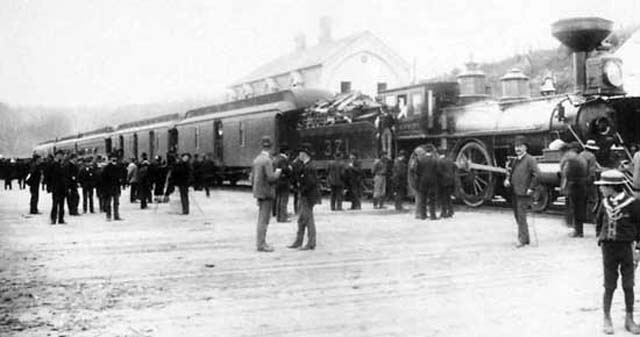 The first transcontinental passenger train to arrive in Port Moody - 4 Jul 1886 Photographer? Passing of "Pacific Railway" Bill in 1881 Began Canada's New Era Law Approved by Parliament Granted Right to Build a Railroad to Join British Columbia with the Canadas and Thus Fullfil the Pledges of Confederation Today the Canadian Pacific Railway celebrates its Diamond Jubilee, commemorating a date which, like all dates marking the progress of negotiations leading to the birth of the C.P.R., was of fateful significance to both the Dominion of Canada and the British Empire. The event which occurred on February 15, 1881, was the passing of a bill by Parliament at Ottawa, which, when it received the royal assent and became law, granted to the syndicate which later became the Canadian Pacific Railway Company the right to build a railway to join British Columbia with the Canadas. The passing of this act marked the end of a long period of uncertainty as to whether the much-needed "Pacific Railway" would ever be undertaken at all. Trials, disappointments, heartbreaks even, lay in the path of the great and determined men who undertook to build the railway, but for the far-sighted statesmen and businessmen of Britain and Canada the first worry was past. The Canadian Parliament had declared for it. With energy and determination it would be built. The "Pacific Railway" idea, whose greatest protagonists were Sir John A. Macdonald, first Premier of Canada, and his great Minister of Railway, Sir Charles Tupper, was stimulated by several factors, strongest of which were the opening of the Japanese Empire to occidental trade, the need of a faster route to China than via the Suez Canal, the desire of Imperial statesmen for an All-British (All-Red) route to Australia and New Zealand, fear of Russian imperialism on the Pacific Coast, preservation of British North America as a British Dominion by uniting British Columbia with the rest of Canada, and a competitive spirit resulting from the building of the Union Pacific Railroad in the United States. If these reasons were not sufficient to impel fore-sighted statesmen to urge construction of the Canadian Pacific Railway, there was still another, danger of the invasion of the Canadian West by branch lines from the Northern Pacific, which if effected would prove a supreme danger to the future of Canada and the development of the Canadian West as a Canadian project. During ten years of construction under Government auspices only 713 miles of track were built, though surveys made were innumerable. Worn out by the apparent hopelessness of its own efforts and fearful that Confederation would lose the adherence of British Columbia, which had been promised the transcontinental railway as an essential condition of joining Confederation, Sir John A. Macdonald eventually succeeded in persuading George Stephen, Scottish-born merchant and director of the Bank of Montreal, and a small group of associates to form a syndicate to undertake the building of the line. On February 16, 1881, the bill granting a charter to the syndicate received its final reading and the signature of the Governor-General, and became law. The management of the new company began its task with energy. Periods of hope and progress were succeeded by financial crises and finally the company was saved from a critical position only by its quickness to take proper advantage of an unusual set of circumstances. The value of the railway to Canada and the Empire was proved by the speed with which troops were rushed to the west to deal with the second rebellion under the leadership of Louis Riel. Sir John A. Macdonald was able to convince the House of the necessity of the railroad, and a much-needed loan was authorized. COMPLETED IN 1885 Following the suppression of the rebellion, the importance of the Canadian Pacific was recognized in England as well as in Canada and British money for construction came forward more freely. The line was completed on November 7, 1885 with the driving of the Last Spike by Donald Smith, later Lord Strathcona, at Craigellachie in the Eagle Pass in British Columbia. Celebration of the completion of the railway, however, was deferred until the following year when on June 28, 1886 the first through transcontinental passenger train left Montreal for Port Moody, then the western terminus of the line. This event was the occasion for celebration on a national scale. From the time of the departure at Montreal until the train reached the Pacific Coast there was a series of enthusiastic celebrations right across file country. Canada was given an entirely new aspect in the eyes of Europeans when, within a year of the completion of the line, the company was able, by sound financing to pay every cent of its indebtedness. Its own credit abroad and that of the Dominion too was firmly established on the sound footing it has since enjoyed. Immediately after the opening of the railway. Stephen and Van Horne and their able associates set out to populate the western plains with settlers and to induce travellers from home and abroad to visit the magnificent scenic features of its route. The organization had been thorough and the work throughout had been well done. The auxiliary organizations, such as telegraphs, express and sleeping and dining-car services had been retained as integral parts of the parent company. The foundation of the world's future largest transportation system had been solidly laid, but the task of erecting the superstructure was only less formidable than that which had preceded it. Happily the president and his executive officers had about them an army of tried and proven men whose loyalty to the institution and what it stood for was not even exceeded by their outstanding capabilities. Together they tackled the new task and right well they performed it. It was not long before the Canadian Pacific was telling the world about Canada, the new land of promise, with the result that settlers poured into the country, and the West began to assume the look of a populated land. THE WEST DEVELOPED In earlier years Canadians had gone south to the United States in their quest for new fields and opportunities. Now the West beckoned and the response was wholehearted. Some of the twenty-five million acres that had come to the Company as part of the government's payment for work done began to produce wealth. Worthless in the days before the railway had made them accessible, they had been sold at modest prices and on generous long terms. The land was without value to anyone until occupied and worked. To induce settlement it was put on the market at a flat price of $2.50 per acre and sold under a contract providing that at least one half the area must be broken and cultivated, while, to encourage the purchasers, the company granted a rebate of half the purchase price, $1.25 per acre, for all the land so put to the plow. Progress and development of the railway was continuous. Branch lines were extended through the West and in the East, too, rapid and solid progress was made. Soon after the turn of the century, the Canadian Pacific, which had operated steamers on the Pacific Ocean between British Columbia and the Orient since its earliest days, turned its attention to the Atlantic and purchased many of the ships of the passenger fleet of the Elder Dempster Beaver Line. This was the beginning of that great fleet which reached its greatest peak of development during the post-war years, when for many seasons some 120,000 passengers were annually carried across the Atlantic in ships of the Canadian Pacific fleet. The scope of the Canadian Pacific Railway today can be gathered from the fact that in 1940 the company carried nearly eight million passengers over a total of 924 million passenger miles in addition to transporting approximately 37 million tons of freight over 36 billion ton miles. During 1940, too, the Company paid out more than nine million dollars in taxes, and is still Canada's largest taxpayer having paid out since incorporation approximately 172 million dollars in federal, provincial, and municipal taxes. The company's increasing prosperity and usefulness is most easily traced, however, in the statements of gross earnings, because every dollar of earnings represents a certain measure of public service rendered. From less than a million dollars in 1881 the gross earnings of the company lumped to more Than eight million in 1885, to sixteen and one-half million in 1890, and in 1928 reached a record figure of $238,691,000. HUGE FLOW OF COMMERCE The flow of the nation's commerce is perhaps the truest gauge of national prosperity and Canadian Pacific figures in that respect are impressive. In 1886, the earliest record available, the company carried two million tons of freight earning slightly more than six million dollars. In 1940 the freight carried on company lines had increased to thirty-seven million tons. These figures reflect the growth of industry, agriculture, and population in Canada. In the same period the acreage of Canada's farms increased from 45 to 163 million, while the value of field crops increased from 155 to 651 millions of dollars, and the value of dairy products increased from 23 to 218 millions of dollars. Last year's crops of more than 551 and 380 millions of bushels of wheat and oats respectively make an impressive comparison against the 32 million bushels of wheat and 70 million bushels of oats produced in Canada in 1881. At the same time industry took giant strides, the gross value of manufactures increased from $309,676,068 in 1881 to more than three and a third billions in 1938. At the moment, with the world at war, Canada has the fullest possible support of the Canadian Pacific Railway. In the first World War, from 1914 to 1918, the company played a vital role in the transportation of troops and equipment over land and sea, the same thing is true now, but in a greater extent because of increased equipment and efficiency. From 1914 to 1918 the company gave 11,340 of its employees to the colors and of these 1,116 were killed in action and 2,105 were wounded. Company men are again playing their part in practically every theatre of war. Company ships are again an important factor. Thirteen were lost by enemy action in the last war, in this conflict the proud Empress of Britain and others have already been lost or damaged. Company shops are again doing war work, company men have been lent to the Governments of Great Britain and Canada for special work and the entire staff is playing a patriotic part in supporting the war effort in every possible way and to the fullest possible extent. The history of the Canadian Pacific Railway is yet in its first chapters. The first sixty years have simply been preparation for the great part it hopes to play in the greater Canada that is to be. Railroaders of three generations have already done their share toward empire-making under the guidance of the company's four presidents, Lord Mount Stephen, Sir William Van Horne, Lord Shaughnessy, and the present chairman and president, Sir Edward Beatty. Future generations will carry on the tradition of service and loyalty to the nation as well as the great transportation system which has been created by and for, the people of Canada. 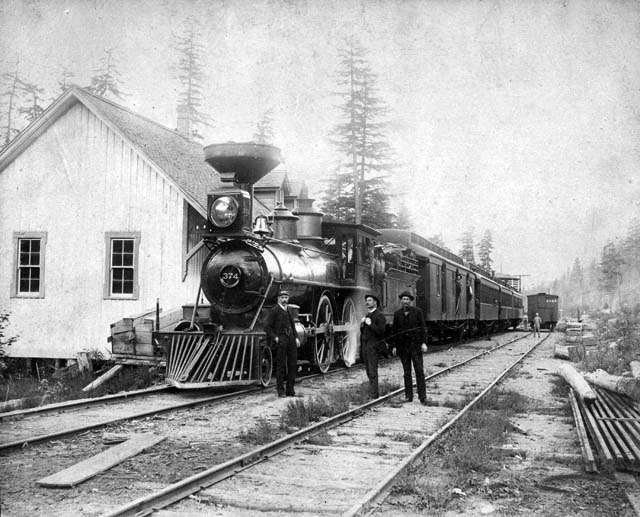 CP 374 with transcontinental passenger train - Circa 1887 Photographer? - Mrs. R. Maynard's Photographic Studio.  DRooPED FILAMENTS 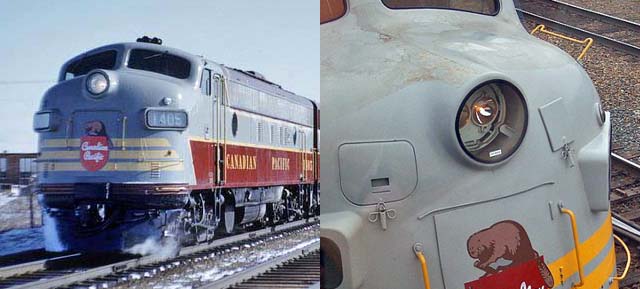 CP F unit headlights, single bulb on left, sealed-beam lights on right - Date? Photographer? One of maintenance's pet peeves were drooped filaments.  CPR General Motors Division model FP9A number 1408 class DPA-17a, built in 1954 with 1,750 horsepower, was wrecked during 1977. 
C.P.R. Steel Hopper 75-Ton Grain Car 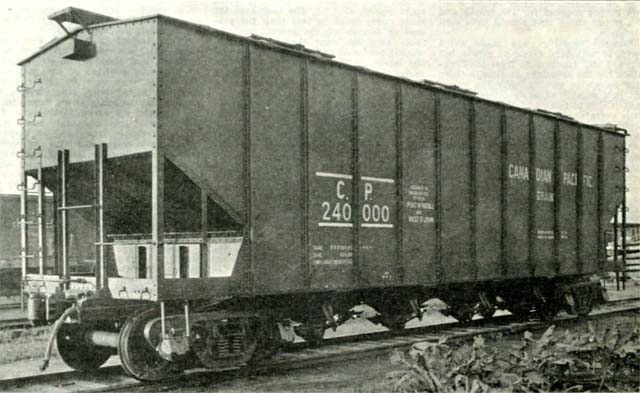 Steel Hopper Grain car, 75 tons capacity, Canadian Pacific Railway. The car illustrated on this page was built recently at the C.P.R. Angus shops, Montreal, to determine, by actual service test, the net advantages to be obtained from a grain tight, self clearing, car of maximum tonnage capacity, as compared with standard box cars of ordinary capacity. The basis of the design for tonnage is 4 M.C.B. axles, having 6 x 11 inch journals. The length was determined by the distance, center to center, of unloading hoppers in the modern elevators at Montreal and West St. John, New Brunswick, there is one elevator having hopper centers 48 feet. The height was determined by the actual cubic space required to contain the full load of wheat, plus an allowance of at least 12 inches on top to permit of full load being placed in the car without trimming. The car is all steel, with the exception of the running board and the ridge on top of the center sill. The general design is practically the same as commonly used for coal cars of equal capacity, except that this car is built with a steel roof. The roof is provided with 3 hatch openings on each side of the running board. The hoppers are arranged 4 on each side of the center sill. The hopper openings are purposely made relatively small, and the frame and slides are machined and carefully fitted. The slides are opened and closed by a rack and pinion arrangement. The slides are locked by a sealing pin passing through the slide and hopper frame. The trucks are Vulcan type, built to U.S.R.A. dimensions. The car, having given satisfactory performance on its initial trip between Port McNicoll, Ontario, and Montreal, has been placed in regular service between the same port and West St. John, New Brunswick. We are indebted to W.H. Winterrowd, Chief Mechanical Engineer, C.P.R., for the foregoing particulars. 
Four Outstanding Men Have Led Canadian Pacific in its 60 Years Four outstanding men, two of them Americans, one a Scot, and the other a Canadian, have guided the destiny of the Canadian Pacific Railway Company in the sixty years that have passed since the company received its charter from the Sir John A. Macdonald Government on 15 Feb 1881 and was officially organized two days later. Lord Mount Stephen, the organizer, Sir William Van Horne, the builder, Lord Shaughnessy, the developer, and Sir Edward Beatty, the modernizer, succeeded in that order to the presidential chair. Each man was blessed with a strong character and love of country, each possessed abilities and ideals to match the varied conditions encountered in his term of office, each had the strength of will to meet all emergencies and overcome all obstacles. Lord Mount Stephen headed the syndicate that agreed to build the transcontinental railway after everyone else had failed. He overcame the most exacting of financial difficulties and fought off the bitterest of political enmity. Sir William Van Horne was the man who built the transcontinental line in half the time agreed to in the contract and who put the line on a firm, paying basis. Lord Shaughnessy brought about its great expansion in the early part of the century and aided in the settlement and development of the West. Sir Edward Beatty has led the company through the most prosperous as well as the most depressed years in the history of the world, adjusted the company to meet the severest sort of artificially created competition and is giving the company the highest kind of leadership under the new conditions caused by the war. 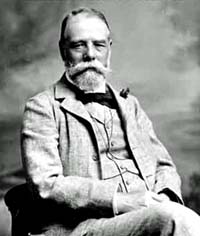 George Stephen, who earned his first wages as a farmhand in Scotland and who made a respectable fortune by dint of hard work, became the Canadian Pacific Railway's first president against his will. He was coaxed into the project by Sir John A. Macdonald, not because of the profits to be gained but because of national need of a railway and the benefit it would be to the British Empire. It needed a man like that to live up to the role cast for him in the great project. Books have been written about the task of conquering the Rockies, and the building of the line across the north shore of Lake Superior at a cost of half a million dollars a mile in places. His was the task to borrow money and more money from Parliament to try to dispose of company bonds on unfavourable markets, to hold off the creditors, to fight off the line's opponents. The heads of the company put every cent of their personal fortunes into the venture and on one occasion Lord Strathcona summed up their situation with the words "It may be that we must succumb, but that must not be as long as we individually have a dollar." And that was their approximate financial situation in 1885, the year the line was completed. But George Stephen had the satisfaction of seeing every cent of indebtedness repaid. In 1888 he resigned from the presidency, his health undermined by the terrific strain of his eight years as head of the company. His services were recognized by the Crown and he became a baronet in 1886, was elevated to the peerage in 1891 with the title Baron Mount Stephen, and was created a Knight Grand Cross of the Royal Victorian Order in 1905. NOTHING IS IMPOSSIBLE 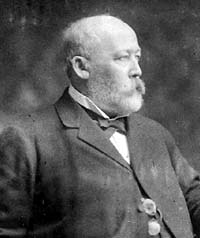 William Van Horne built the road in five years on the principle that "Nothing is impossible. If you can, show me the road that is all I want, if you can not, I will have your scalp." and his speech at the ceremony of the driving of the Last Spike consisted of the words, "All I can say is that the work has been well done in every way." Of Dutch parentage but American-born, he was a railroader from the age of 14 and at 29 was general superintendent of the St. Louis Kansas City & Northern Railway. When he became president in August, 1888, the line had been built but branch lines, connections with American roads, and ocean traffic had to be assured. The steamship service to the Orient, which he had advocated, came into being at this time largely through his efforts. During Van Horne's term of presidency, from 1888 to 1899, the company's gross earnings increased from $13,195,000 to $219,230,000 and track mileage increased from 5,074 to 7,982. In 1888 the company had 16,000 employees with a payroll of approximately $7,000,000 and in 1899 there were between 21,000 and 22,000 employees earning $10,000,000. His services to his adopted country earned the thanks of Queen Victoria who conferred upon him the order of Knight Commander of St. Michael and St. George in 1894. 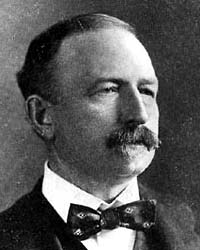 T.G. Shaughnessy's early days with the Canadian Pacific Railway were in the capacity of chief purchasing agent and his code of ethics was severe but simple. The only factors that he considered in Canadian Pacific purchases were price, quality, and rapidity of delivery. That one prominent director resigned because his friends did not receive preferred treatment, did not worry Shaughnessy in the least. During the mad dash of construction across the prairies the men at the front were never delayed a minute because of absence of supplies, although Shaughnessy had to practice desperate diplomacy because of shortage of funds. His chief pride was, however, that not a man lost a dollar by responding to his persuasion. FIVE NOTABLE EVENTS In his term as president, from 1899 to 1918, the five outstanding events were: The settlement and first real development of the prairies. The inauguration of a steamship service on the Atlantic Ocean. The acquisition of a smelter and mines in Southern British Columbia and their development under the control of the Consolidated Mining and Smelting Company. The birth, growth, and death of the Canadian Northern Railway System, and the extension of the Grand Trunk to the Pacific Ocean. The Great War and its disastrous reactions on the railway situation in Canada. This remarkable man was born an American but he did more than all but a very few Canadians have accomplished toward the development of the Dominion. Under his leadership the Canadian Pacific Railway expanded tremendously. Gross earnings increased from $29,230,000 to $157,357,000. The mileage of the railway was 7,739 in 1918 and 13,772 when he resigned the presidency. Assets of the company in the same period increased from $279,418,000 to $1,055,273,000. A tenure of office which produces growth of this magnitude is sufficient testimonial to the worth of the man. T.G. Shaughnessy was knighted in 1901 and made a Knight Commander of the Royal Victorian Order in 1907. In 1916 he was raised to the peerage for his services to the British Empire, with the title of Baron Shaughnessy. 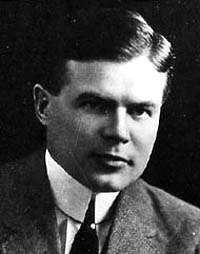 Edward Wentworth Beatty was the first Canadian to become president of the Canadian Pacific Railway and at the time of his appointment 10 Oct 1913 he was not only the youngest railway president in the world but also president of the world's largest privately-owned transportation system. During his more than 22 years of office he has been a great railroader. His good citizenship and his tremendous capacity for work are reflected by his will to serve in every possible way. He holds positions of importance in a score of other companies, is a leader in the affairs of colleges and hospitals, and has done outstanding work with organizations seeking improvements in conditions for Canadians across the country. His regime with the Canadian Pacific Railway has been most eventful. The guns of the Great War were still firing when he was elected president. Then came the post-war depression, the greatest business boom in the history of the world, and the worst depression the world has ever known. Thrust on top of all this has been the need to modernize property and equipment to meet changing conditions and the unceasing attempt to rationalize the severest sort of artificially created competition caused by the government railways, the highways, and subsidized canals. 
Attachment for Ballast Spreader 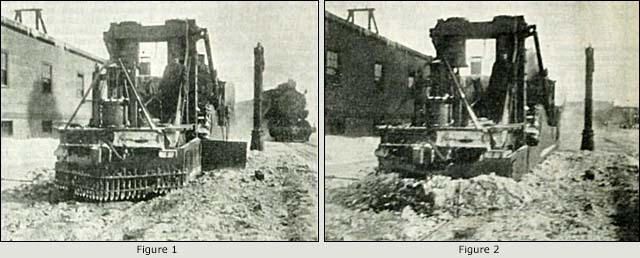 The attachment to a ballast spreader, illustrations of which, from photographs taken on a locomotive back at a terminal on the Eastern Lines C.P.R., are given herewith. It consists of a steel channel frame, designed to fit snugly over the front of the spreader plow, over all, without the removal of anything on the spreader. The channel contains a set of chisels, and is fastened to the front of the spreader plow by special bolts, simply and effectively. Each ice cutting chisel is held in a frame independently. The chisels are interchangeable, and can be quickly and individually removed for redressing. They are also adjustable in the frame to regulate the cut desired below the top of the rail. In this way they can be reground several times, or until the cutting portion is entirely used up and worn out, thereby extending the life of cutters to a maximum. A pair of flanged shoes is fastened under the frame, and the spreader plow front which rides the rails, similar to that of a snow plow, and actuates the device to the center line of the track. Its construction is simple, durable, and inexpensive, combined with special features which render it absolutely effective, for freeing railway tracks, for safe and economical operation, of any ice, frozen cinders, and other elements encountered in winter accumulation, which is especially found in yard terminals, where the climate reaches a very low temperature, and material which could not he removed by any other known means, other than hand picking, which involves manual labour. This renders the ice cutting attachment an enormous labour saver. 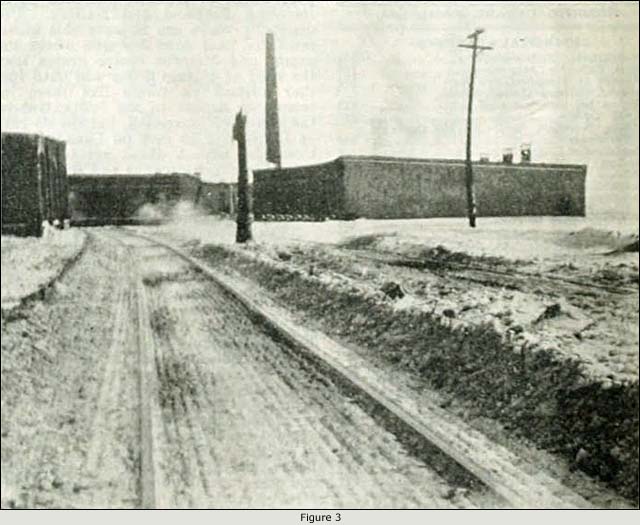 Fig. 1 shows the condition of the tracks previous to running of the ice cutter, accumulation of ice, cinders, and other sediments being well above the top of the rails and frozen very hard. It also shows the arrangement of the cutting chisels in general on the attachment. Fig. 2 shows the machine and device in operation, and Fig. 3 shows the results obtained in one operation, the track freed and cleaned out well below the top of the rails, the depth varying according to desire, as the cutters are adjustable, and cut can be regulated to the depth required. This attachment can be applied conveniently to any car or spreader, but it is best to attach it to a spreader, and also the more economical, as the spreader is in winter used freely for the removal of snow, and this avoids the tying up of other equipment which would be the case if it was applied to a car. The device was tried on the C.P.R. in 1918-1919, and proved so successful that this winter there are some 20 attachments in service on the Eastern Lines. One man operates the spreader, easily raising and lowering it for obstructions, and it will do the work of hundreds of men, and besides the saving in this respect, it gives quick use of yard tracks, as it only takes a few minutes to remove the cars, run the ice cutter through, and put the cars back. 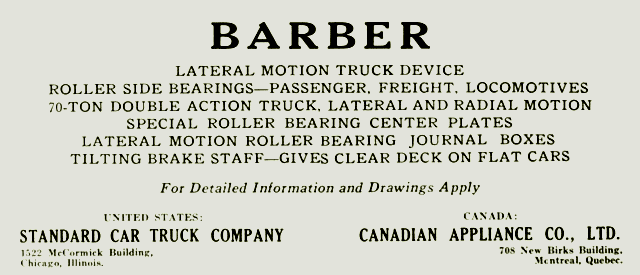 
Rules for Inspection of Locomotives and Tenders 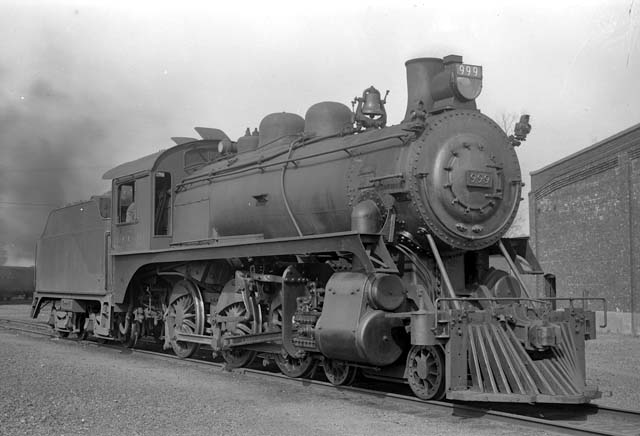 Canadian Pacific Railway Ten-Wheeler number 999 - Date? Photographer? The Board of Railway Commissioners passed general order 289, 24 Mar 1920, as follows: Re consideration of adoption by railway companies of rules relative to inspection of locomotives and tenders. In pursuance of powers conferred upon the board by the Railway Act, 1919, Sec. 297, and of all other powers possessed by it in that behalf, and upon reading the submissions filed by the Railway Association of Canada and the Canadian Pacific and Grand Trunk Railways, and the report and recommendation of the board's Chief Operating Officer, it is ordered that railway companies adopt and put into force, not later than 1 Jun 1920, the rules relative to the inspection of locomotives and tenders, hereto attached marked "A". "A" Rules relative to inspection of locomotives and tenders. Every locomotive and tender shall be inspected after each trip, or day's work. The employee making the inspection shall report all defects found, in report book. Defects reported, which are not repaired before the locomotive is returned to service, shall be filed in the office where the inspection is made. Air Brakes. It must be known before each trip that the brakes on locomotive and tender are in safe and suitable condition for service, that the air compressor or compressors are in condition to provide an ample supply of air for the service in which the locomotive is used, and that all other devices for controlling or regulating the pressure are properly maintained. Testing Main Reservoirs. Every main reservoir, before being put into service, and at least each 12 months thereafter, shall be subjected to hydrostatic pressure, not less than 25 percent above the maximum allowed air pressure. The entire surface of the reservoir shall be hammer tested each time the locomotive is shopped for general repairs, but not less frequently than once each 18 months. The draw gear between the Locomotive and Tender, together with the pins and fastenings, shall be maintained in safe and suitable condition for service. The pins and drawbar shall be removed and carefully examined for defects not less frequently than once each 3 months. Suitable means for securing the drawbar pins in place shall be provided. Inverted drawbar pins shall be held in place by plate or stirrup. (b) Two or more safety bars or safety chains of ample strength shall be provided between locomotive and tender (except when double drawbars are used), maintained in safe and suitable condition for service, and inspected at the same time draw gear is inspected. (c) Safety chains or safety bars shall be of the minimum length consistent with the curvature of the railway on which the locomotive is operated. (d) Lost motion between locomotives and tenders not equipped with spring buffer, shall be kept to a minimum and shall not exceed 1/2 inch. (e) When spring buffers are used between locomotives and tenders, the spring shall be applied with not less than 3/4 inch compression, and shall at all times be under sufficient compression to keep the chafing faces in contact. Chafing Irons of such radius as will permit proper curving shall be securely attached to locomotive and tender, and shall be maintained in condition to permit free movement laterally and vertically. Draft gear and attachments on locomotives and tenders shall be securely fastened and maintained in safe and suitable condition for service. Cab Lights. Each locomotive, used between sunset and sunrise, shall have cab lamps, which will provide sufficient illumination for the steam, air, and water gauges, to enable the enginemen to make necessary and accurate readings from their usual and proper positions in the cab. These lights shall he so located and constructed that the light will shine only on those parts requiring illumination. Locomotives used in road service shall have an additional lamp, conveniently located, to enable the persons operating the locomotive to easily and accurately read train orders and time tables, and so constructed that it may be readily darkened or extinguished. The total lateral motion, or play, between the hubs of the wheels and the boxes on any pair of wheels shall not exceed the following limits: For engine truck wheels (trucks with swing centers)...... 1 inch. For engine truck wheels (trucks with rigid centers)........ 1 1/2 inches. For trailing truck wheels............................................. 1 inch. For driving wheels (more than 1 pair) not more than...... 3/4 inch. These limits may be increased on locomotives operating on track where the curvature exceeds 20 degrees, when it can be shown that conditions require additional lateral motion. Pilots shall be securely attached, properly braced, and maintained in a safe and suitable condition for service. The minimum height from the rail 3 inches and the maximum 6 inches. |